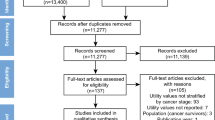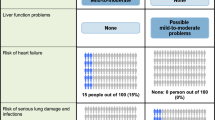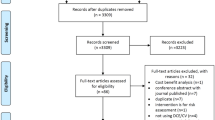Abstract
BACKGROUND: Black, older, and less affluent women are less likely to receive adjuvant breast cancer therapy than their counterparts. Whereas preference contributes to disparities in other healt care scenarios, it is unclear if preference explains differential rates of breast cancer care.
OBJECTIVE: To ascertain utilities from women of diverse backgrounds for the different stages of, and treatments for, breast cancer and to determine whether a treatment decision modeled from utilities is associated with socio-demographic characteristics.
PARTICIPANTS: A stratified sample (by age and race) of 156 English-speaking women over 25 years old not currently undergoing breast cancer treatment.
DESIGN AND MEASUREMENTS: We assessed utilities using standard gamble for 5 breast cancer stages, and time-tradeoff for 3 therapeutic modalities. We incorporated each subject’s utilities into a Markov model to determine whether her quality-adjusted life expectancy would be maximized with chemotherapy for a hypothetical, current diagnosis of stage II breast cancer. We used logistic regression to determine whether socio-demographic variables were associated with this optimal strategy.
RESULTS: Median utilities for the 8 health states were: stage I disease, 0.91 (interquartile range 0.50 to 1.00); stage II, 0.75 (0.26 to 0.99); stage III, 0.51 (0.25 to 0.94); stage IV (estrogen receptor positive), 0.36 (0 to 0.75); stage IV (estrogen receptor negative), 0.40 (0 to 0.79); chemotherapy 0.50 (0 to 0.92); hormonal therapy 0.58 (0 to 1); and radiation therapy 0.83 (0.10 to 1). Utilities for early stage disease and treatment modalities, but not metastatic disease, varied with socio-demographic characteristics. One hundred and twenty-two of 156 subjects had utilities that maximized quality-adjusted life expectancy given stage II breast cancer with chemotherapy. Age over 50, black race, and low household income were associated with at least 5-fold lower odds of maximizing quality-adjusted life expectancy with chemotherapy, whereas women who were married or had a significant other were 4-fold more likely to maximize quality-adjusted life expectancy with chemotherapy.
CONCLUSIONS: Differences in utility for breast cancer health states may partially explain the lower rate of adjuvant therapy for black, older, and less affluent women. Further work must clarify whether these differences result from health preference alone or reflect women’s perceptions of sources of disparity. such as access to care, poor communication with providers, limitations in health knowledge or in obtaining social and workplace support during therapy.
Similar content being viewed by others
References
Jazieh AR, Buncher CR. Racial and age-related disparities in obtaining screening mammography: results of a statewide database. South Med J. 2002;95:1145–8.
Peek ME, Han JH. Disparities in screening mammography. Current status, interventions and implications. J Gen Intern Med. 2004;19:184–94.
Pearlman DN, Rakowski W, Ehrich B, Clark MA. Breast cancer screening practices among black, Hispanic, and white women: reassessing differences. Am J Prev Med. 1996;12:327–37.
Chang SW, Kerlikowske K, Napoles-Springer A, Posner SF, Sickles EA, Perez-Stable EJ. Racial differences in timeliness of follow-up after abnormal screening mammography. Cancer. 1996;78:1395–402.
Rakowski W, Breen N, Meissner H, et al. Prevalence and correlates of repeat mammography among women aged 55–79 in the Year 2000 National Health Interview Survey. Prev Med. 2004;39:1–10.
Keating NL, Landrum MB, Ayanian JZ, Winer EP, Guadagnoli E. The association of ambulatory care with breast cancer stage at diagnosis among Medicare beneficiaries. J Gen Intern Med. 2005;20:38–44.
Roetzheim RG, Pal N, Tennant C, et al. Effects of health insurance and race on early detection of cancer. J Natl Cancer Inst. 1999;91:1409–15.
Elmore JG, Nakano CY, Linden HM, Reisch LM, Ayanian JZ, Larson EB. Racial inequities in the timing of breast cancer detection, diagnosis, and initiation of treatment. Med Care. 2005;43:141–8.
Ayanian JZ, Guadagnoli E. Variations in breast cancer treatment by patient and provider characteristics. Breast Cancer Res Treat. 1996;40:65–74.
Payne R, Medina E, Hampton JW. Quality of life concerns in patients with breast cancer: evidence for disparity of outcomes and experiences in pain management and palliative care among African-American women. Cancer. 2003;97:311–7.
Joslyn SA. Racial differences in treatment and survival from early-stage breast carcinoma. Cancer. 2002;95:1759–66.
Li CI, Malone KE, Daling JR. Differences in breast cancer stage, treatment, and survival by race and ethnicity. Arch Intern Med. 2003;163:49–56.
Shavers VL, Harlan LC, Stevens JL. Racial/ethnic variation in clinical presentation, treatment, and survival among breast cancer patients under age 35. Cancer. 2003;97:134–47.
Shavers VL, Brown ML. Racial and ethnic disparities in the receipt of cancer treatment. J Natl Cancer Inst. 2002;94:334–57.
Du XL, Key CR, Osborne C, Mahnken JD, Goodwin JS. Discrepancy between consensus recommendations and actual community use of adjuvant chemotherapy in women with breast cancer. Ann Intern Med. 2003;138:90–7.
Du X, Goodwin JS. Patterns of use of chemotherapy for breast cancer in older women: findings from Medicare claims data. J Clin Oncol. 2001;19:1455–61.
Griggs JJ, Sorbero ME, Stark AT, Heininger SE, Dick AW. Racial disparity in the dose and dose intensity of breast cancer adjuvant chemotherapy. Breast Cancer Res Treat. 2003;81:21–31.
Gordon NH. Socioeconomic factors and breast cancer in black and white Americans. Cancer Metastasis Rev. 2003;22:55–65.
Brawley OW. Disaggregating the effects of race and poverty on breast cancer outcomes. J Natl Cancer Inst. 2002;94:471–3.
Chu KC, Tarone RE, Brawley OW. Breast cancer trends of black women compared with white women. Arch Fam Med. 1999;8:521–8.
Newman LA, Mason J, Cote D, et al. African-American ethnicity, socioeconomic status, and breast cancer survival: a meta-analysis of 14 studies involving over 10,000 African-American and 40,000 White American patients with carcinoma of the breast. Cancer. 2002;94:2844–54.
Ghafoor A, Jemal A, Ward E, Cokkinides V, Smith R, Thun M. Trends in breast cancer by race and ethnicity. CA Cancer J Clin. 2003;53:342–55.
Russell A, Langlois T, Johnson G, Trentham-Dietz A, Remington P. Increasing gap in breast cancer mortality between black and white women. World Med J. 1999;98:37–9.
Ayanian JZ, Kohler BA, Abe T, Epstein AM. The relation between health insurance coverage and clinical outcomes among women with breast cancer. N Engl J Med. 1993;329:326–31.
Smedley BD, Stih AY, Nelson AR, eds. Unequal Treatment: Confronting Racial and Ethnic Disparities in Health Care. Washington, DC: The National Academies Press; 2003.
Early Breast Cancer Trialists’ Collaborative Group (EBCTCG). Effects of chemotherapy and hormonal therapy for early breast cancer on recurrence and 15-year survival: an overview of the randomised trials. Lancet. 2005;365:1687–717.
Peele PB, Siminoff LA, Xu Y, Ravdin PM. Decreased use of adjuvant breast cancer therapy in a randomized controlled trial of a decision aid with individualized risk information. Med Decision Making. 2005;25:301–7.
Gold MR, Patrick DL, Torrance GW, et al. Identifying and valuing outcomes. In: Gold MR, Siegel JE, Russell LB, Weinstein MC, eds. Cost-Effectiveness in Health and Medicine. New York: Oxford University Press; 1996:82–134.
Naglie G, Krahn MD, Naimark D, Redelmeier DA, Detsky AS. Primer on medical decision analysis: part 3—Estimating probabilities and utilities. Med Decision Making. 1997;17:136–41.
vonNeumann J, Morgenstern O. Theory of Games and Economic Behavior. Princeton, NJ: Princeton University Press; 1944.
Earle CC, Chapman RH, Baker CS, et al. Systematic overview of cost-utility assessments in oncology. J Clin Oncol. 2000;18:3302–17.
Jansen SJ, Kievit J, Nooij MA, et al. Patients’ preferences for adjuvant chemotherapy in early-stage breast cancer: is treatment worthwhile? Br J Cancer. 2001;84:1577–85.
Singletary SE, Allred C, Ashley P, et al. Staging system for breast cancer: revisions for the 6th edition of the AJCC Cancer Staging Manual. Surg Clin North Am. 2003;83:803–19.
Dow KH, Lafferty P. Quality of life, survivorship, and psychosocial adjustment of young women with breast cancer after breast-conserving surgery and radiation therapy. Oncol Nurs Forum. 2000;27:1555–64.
Dow KH, Ferrell BR, Leigh S, Ly J, Gulasekaram P. An evaluation of the quality of life among long-term survivors of breast cancer. Breast Cancer Res Treat. 1996;39:261–73.
Ferrell BR, Grant MM, Funk BM, Otis-Green SA, Garcia NJ. Quality of life in breast cancer survivors: implications for developing support services. Oncol Nurs Forum. 1998;25:887–95.
Mast ME. Survivors of breast cancer: illness uncertainty, positive reappraisal, and emotional distress. Oncol Nurs Forum. 1998;25:555–62.
Kennedy ED, Detsky AS, Llewellyn-Thomas HA, et al. Can the standard gamble be used to determine utilities for uncertain health states? An example using postoperative maintenance therapy in Crohn’s disease. Med Decision Making. 2000;20:72–8.
Gail MH, Brinton LA, Byar DP, et al. Projecting individualized probabilities of developing breast cancer for white females who are being examined annually. J Natl Cancer Inst. 1989;81:1879–86.
Bala MV, Wood LL, Zarkin GA, Norton EC, Gafni A, O’Brien BJ. Are health states “timeless”? The case of the standard gamble method. J Clin Epidemiol. 1999;52:1047–53.
Franic DM, Pathak DS, Gafni A. Are health states “timeless”? A case study of an acute condition: post-chemotherapy nausea and vomiting. J Eval Clin Pract. 2003;9:69–82.
Fortin JM, Hirota LK, Bond BE, O’Connor AM, Col NF. Identifying patient preferences for communicating risk estimates: a descriptive pilot study. BMC Med Inform Decision Making. 2001;1:2.
Torrance G. Social preferences for health states: an empirical evaluation of three measurement techniques. Socio-Econom Planning Sci. 1976;10:129–36.
Torrance G, Thomas W, Sacket D. A utility maximization model for evaluation of health care programs. Health Serv Res. 1972;7:118–33.
Torrance G. Measurement of health state utilities for economic appraisal. J Health Econ. 1986;5:1–30.
Llewellyn-Thomas H, Sutherland HJ, Tibshirani R, Ciampi A, Till JE, Boyd NF. The measurement of patients’ values in medicine. Med Decision Making. 1982;2:449–62.
Redelmeier DA, Heller DN. Time preference in medical decision making and cost-effectiveness analysis. Med Decision Making. 1993;13:212–7.
Hoyert D, Arias E, Smith B, Murphy S, Kochanek M. Deaths: final data for 1999. Natl Vital Stat Rep. 2001;49.
Cykert S, Phifer N. Surgical decisions for early stage, non-small cell lung cancer: which racially sensitive perceptions of cancer are likely to explain racial variation in surgery? Med Decision Making. 2003;23:167–76.
Bruner DW, Hanlon A, Mazzoni S, et al. Predictors of preferences and utilities in men treated with 3D-CRT for prostate cancer. Int J Radiat Oncol Biol Phys. 2004;58:34–42.
Knight SJ, Siston AK, Chmiel JS, et al. Ethnic variation in localized prostate cancer: a pilot study of preferences, optimism, and quality of life among black and white veterans. Clin Prostate Cancer. 2004;3:31–7.
Tsevat J. What do utilities measure? Med Care. 2000;38:160–164.
Feeny DH, Torrance GW. Incorporating utility-based quality-of-life assessment measures in clinical trials. Two examples. Med Care. 1989;27:S190–204.
Bleichrodt H, Johannesson M. The validity of QALYs: an experimental test of constant proportional tradeoff and utility independence. Med Decision Making. 1997;17:21–32.
Bleichrodt H, van Rijn J, Johannesson M. Probability weighting and utility curvature in QALY-based decision making. J Math Psychol. 1999;43:238–60.
NCI. Surveillance Epidemiology and End Results (SEER). Cancer Statistics. Available at: http://seer.cancer.gov/. Accessed August 30, 2005.
Author information
Authors and Affiliations
Corresponding author
Additional information
No conflicts of interest to declare.
This project and Mark Schleinitz were supported by NIH, Office of Research in Women’s Health BIRCWH Grant HD43447, administered through Women and Infants’ Hospital, Providence, RI.
Rights and permissions
About this article
Cite this article
Schleinitz, M.D., DePalo, D., Blume, J. et al. Can differences in breast cancer utilities explain disparities in breast cancer care?. J GEN INTERN MED 21, 1253–1260 (2006). https://doi.org/10.1111/j.1525-1497.2006.00609.x
Received:
Revised:
Accepted:
Issue Date:
DOI: https://doi.org/10.1111/j.1525-1497.2006.00609.x




